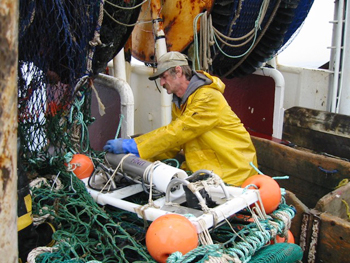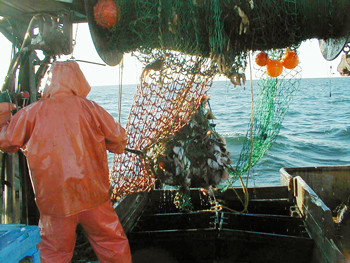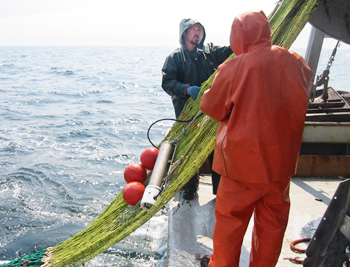Spring 2015
Ocean Science
IN SEPTEMBER OF 2014, with $800,000 in fresh research funds from the New England Fishery Management Council (NEFMC) to administer, the Northeast Consortium put out a region-wide request for proposals to its constituency of commercial fishermen, scientists, and other stakeholders in the Gulf of Maine and Georges Bank.
While a broad range of projects was considered, priority was given to specific proposals that aim to demonstrate how to access closed areas and increase catch of haddock without impacting cod, yellowtail flounder, and windowpane flounder, as well as to studies that develop gear-engineering solutions to minimize bycatch of flatfish.
 |
|
| Fishing crew attaching an underwater camera to a bycatch reduction device to record fish behavior. Photo courtesy of Northeast Consortium. |
The call was answered with 18 proposals submitted from nine different institutions and entities and totaled a whopping $2.5 million in projected costs.
“It was great getting such a response but we didn’t have anything like that amount, and so we had some difficult decisions to make,” notes Chris Glass, director of the Northeast Consortium.
Glass and his review committee eventually whittled it down to four projects running the gamut from the survivability of haddock in recreational fisheries to new trawl gear design and avoidance strategies.
Soon thereafter, the NEFMC unexpectedly released another $200,000 in funding for the consortium to administer, which required an additional request for proposals to be sent out and resulted in roughly doubling the number of funded projects.
“More funds were provided because they realized there were some additional priorities they wanted to address that the original request for proposals did not cover,” Glass says. “One thing they’re concerned about in particular is getting more information about the spawning of groundfish—especially cod—not only where spawning is occurring but information about spawning activity that might allow us to eventually protect these areas better.”
With the supplemental funds, Glass will now fund a total of seven or eight new projects that will help propel the crucial research forward.
The work of the Northeast Consortium has become the standard model for bringing commercial “fishers”—the gender-neutral term used in the industry—and scientists together in an effort to improve fisheries. But in recent years, a significant reduction in funds for supporting the research needed to identify strategies and solutions for the sustainability of fishery resources in the region has hampered further progress.
The consortium was created in 1999 to encourage and fund effective, equal partnerships among commercial fishers, scientists, and other stakeholders to engage in collaborative research and monitoring projects in the Gulf of Maine and Georges Bank. At the time, this approach was highly creative, innovative, and risky; New England fisheries stocks were heavily overfished, restrictions were being imposed and economic hardship was on the rise. In such a climate, commercial fishers were extremely reluctant to team up with scientists.
But today, through the consortium’s work, collaborative partnerships between scientists and fishers are firmly established and represent the most effective way to gather the information required to help rebuild our fishery resources. Moreover, the Northeast Consortium "template" is being replicated elsewhere around the globe and has helped encourage partnerships between fishermen and those who regulate them for the very first time.
However, Glass points out, despite the consortium’s broad successes and the improvement of some fisheries, other stocks continue to be in decline. "So both the initial and supplemental funding represents very forward-thinking on the part of NEFMC,” Glass says.
After the September 2014 request for proposals went out, more recent fisheries stock assessments clearly showed big changes in certain species that the NEFMC wanted to address immediately.
 |
|
| Scientists investigating new net designs to reduce unintended catch of cod. Photo courtesy of Northeast Consortium. |
For cod, for example, the stock assessment revealed that the population of this once super-abundant, signature Gulf of Maine/Georges Bank fish had been reduced to three percent of the level needed to sustain the species.
Says Glass, “What that means is the population is at the very minimum level in order for the stock to be able to sustain any fishery at all—it’s three to four percent of where it should be, which means the stock is, if you believe the assessment, almost reduced to zero.”
Thus, emergency action was required and led to the NEFMC releasing the additional $200,000 in research funds. It also led to the closure of all cod fishing “so people are desperately trying to figure out alternate strategies that will allow them to fish for other species that are rebuilt or better in condition,” says Glass.
 |
|
| Instrumentation being readied for deployment during fishing trials. Photo courtesy of Northeast Consortium. |
An additional and largely unexplored aspect of concern over cod, haddock, and other species is the impact recreational fishing has on the stocks of these fish.
“The impact of recreational fishing has tended to fly under the radar but we know it’s huge,” notes Glass, “the amount of fish being caught recreationally probably exceeds what is caught by the commercial industry but a lot of fish are released. We don’t know what portion survives or dies, we don’t really understand the mortality that’s being imposed on stocks by recreational fisheries, so it’s really critical to understand just how much impact this is having.”
Recreational fishing involves large party or “head boats” that can carry 20 anglers each with an allowed catch. If a section of the sea is dotted with a large number of these boats on any given day, the numbers of fish being caught, and released, quickly adds up.
“It’s big business in this part of the world,” Glass says.
Two of the selected consortium projects are looking at fish that are being released from recreational fishing boats, and both are tag, release, and recapture studies.
“One uses conventional tagging and will release thousands of tagged fish that, when recaptured, will provide an estimate of survivability,” says Glass adding, “and the other is planning to use acoustic telemetry where they’ll be able to follow fish in real time after release from recreational boats.”
Additionally, in a technique pioneered by the Northeast Consortium, each of these projects will be putting scientists and observers on the boats. Recreational fishing traditionally has been a self-reported enterprise, which is of course given to all sorts of inaccuracies for a variety of reasons.
Says Glass, “By getting people out there and monitoring exactly what’s going on and studying this scientifically, we should be getting a much more realistic figure of the mortality.”